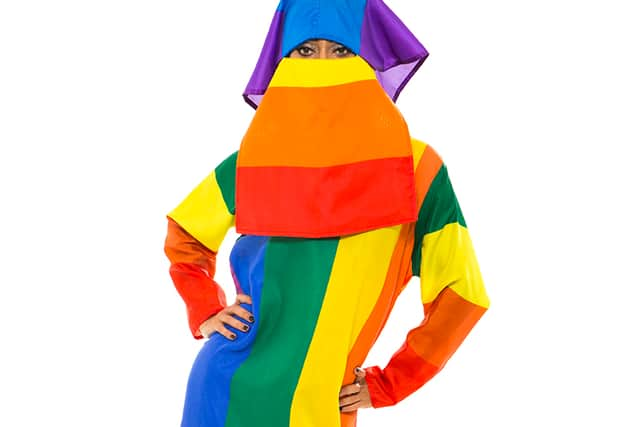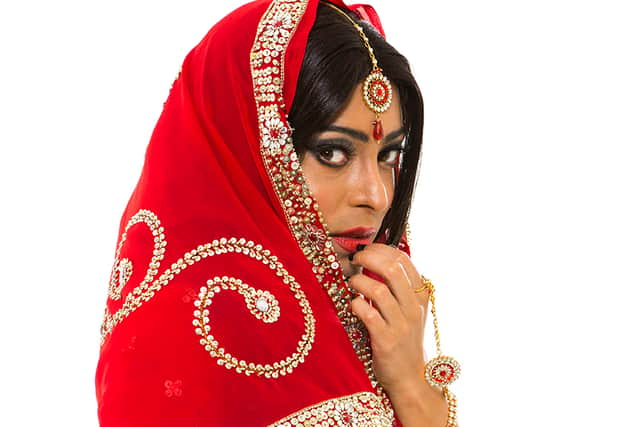The history of British South Asian drag, how Ru Paul’s Drag Race changed the scene and what the future holds
This article contains affiliate links. We may earn a small commission on items purchased through this article, but that does not affect our editorial judgement.
and live on Freeview channel 276
Performance is infused into the human spirit. The instinctive urge to entertain, sculpt stories to music or dance stretches deep into the heart of history. At its core, that’s what drag is – a production of entertainment, borne out of necessity.
Many scholars date drag to the Shakespearian era, 400 years ago, where men dressed as women to represent female characters. Women were prohibited from acting as Church-sanctioned rules dictated only men could take to the stage.
Advertisement
Hide AdAdvertisement
Hide AdThe word drag itself may have developed from a literal illustration of women’s clothing dragging along the stage floor.
But this is a western version of history.
For many South Asians (SA), sometimes the drag scene acts as a bridge to embody a shielded part of their culture where for thousands of years men wore feminine outfits to physically represent who they were, often known as a social transition.
Asifa Lahore, 38, commonly known as ‘Britain’s first out Muslim drag queen’, said: “South Asia managed to get the T (in LGBTQ+) long before the West did.”
The history of SA drag is intertwined with the Hijra community on the Indian subcontinent.
Advertisement
Hide AdAdvertisement
Hide AdHijras, also known as the third gender of India, encompasses anyone not in the binary category of male or female.
They are typically eunuchs, intersex, asexual or transgender people.
The community has a long-standing history of performance and feminine dressing, yet Hijras generally consist of male-born members with only a few born as intersex.
In South Asia, drag emerged from this lifestyle, but it would be wrong to say drag queens are Hijras. Even so, many drag queens ascertain their sexuality and gender identity through their involvement in drag.
The past 10 years
Advertisement
Hide AdAdvertisement
Hide AdWith the rapid rise of Ru Paul’s Drag Race, drag erupted into mainstream media with each series teasing us with sensational ensembles which completely obliterate cultural norms.
The rise of innovative drag outfits parallels a new age of non-binary fashion, where esteemed fashion magazines drip with evolving yet classic fashion statements on what to wear each season.
Yet, whilst applauding this apt growth in the drag community, we’ve neglected to also elevate those who originally sought solace through drag, and now they lag in this rapid expansion.
In other words, we need more SA representation in the entertainment industry and drag is no exception.
Advertisement
Hide AdAdvertisement
Hide AdAsifa Lahore began her journey into drag “by accident” after entering a drag competition 10 years ago.
She said: “In 2011, I’d reached a point in my life where I was out to my parents. I was 27 and I always wanted to perform but I never got a chance to follow a career in the performing arts because I was always scared that my parents would find out about me.
“So, I saw this poster for Drag Idol and my friends said ‘you look great in a dress, and you’re so thin, why don’t you take a chance?’
“I ended up entering this competition, wearing a rainbow burqa singing a parody of Barbie Girl by Aqua which I called Punjabi Girl. I basically ended up winning the bronze award that year and that kick-started my career as a drag artist.”


Advertisement
Hide AdAdvertisement
Hide AdAlthough there is a perennial history of British SA drag artists within the industry, the community is populated mostly with white artists.
In the 1980s, the drag scene was inundated with SA people celebrating their sexuality and gender identity. However, this movement was underground and hushed within British media.
Lahore said: “The reason why I knew (of other SA drag artists) is because in my late teenage years and twenties I would sneak out and go out clubbing in Soho and I became aware of South Asian queer spaces like Club Kali in London, and Saathi (Saathi meaning to have company in Hindi) in Birmingham and Club Zindagi (meaning life in Hindi) in Manchester, and I was very much aware of the Chutney Queen movement. The Chutney Queens were just South Asians drag existing in the UK from the 80s.”
The nickname “Chutney Queen” derived from being South Asian.
Advertisement
Hide AdAdvertisement
Hide AdThe drag scene currently plays with these stereotypes, to which Lahore said: “Looking at these labels through 2021, there’s microaggressions involved.
“But I think the power of drag was owning those microaggressions and racial slurs. The South Asian underground queer scene, especially in the 90s and noughties, was all about just taking back and owning that racism, so the Chutney Queens were just phenomenal.”


But what about the drag scene today?
Although the number of SA drag artists is rising steadily, it’s a delicate dance to create a performance that resonates with your audience but still clings to your culture. Bolly Illusion, a 26-year-old drag queen from west London, has been a dancer all of their life.
Beginning from the tender age of four, they quickly became absorbed in the Indian dance of Bharatanatyam (a traditional Indian Dance) before moving onto Bollywood dance companies.
Advertisement
Hide AdAdvertisement
Hide AdBolly Illusion said their journey into drag happened after they “went to a few gay clubs”.
They said: “I was like, oh my goodness, this looks fun. I was asked to perform at this event called Hungama (meaning ruckus in Hindi), which is a South Asian gay event”.
Eventually they went on to win a competition called Lipsync1000 which catalysed their career as a drag artist.
But for them, there is a sense of duty.
They said: “Sometimes I feel that I have this pressure, because I’m one of the only voices of the South Asian queer scene.
Advertisement
Hide AdAdvertisement
Hide Ad“I’m mixed-cultured in the sense that I’m British, but also Indian. I’m not fully Indian because I wasn’t born in India. I have that British way of living but I still want to showcase how beautiful my culture is, so I do a West meets East routine”.
Bolly Illusion touched on something meaningful during our conversation: representation behind the scenes.
“We both need to be the producers and in the meeting rooms to show our culture in the right way. I don’t want to be able to give my story for free. I don’t want a white person just to take it and run with it, and then I finally see it, it’s the final edit.”


What does the future hold?
Nikkita Chadha, from North London, is a performer and works as an ally to the community but isn’t a drag queen herself.
Advertisement
Hide AdAdvertisement
Hide AdShe said: “I hope it becomes bigger and South Asians in the drag world get even more visibility because it’s such an amazing place to be, that aspect of community it’s something I love and all my friends are involved in.”
Both Lahore and Bolly Illusion want to see a space where more South Asians take to the stage and express who they are.
Lahore said: “In the last five years, I’ve seen a rise of South Asian drag artists that want to be out there in the open.”
But what Bolly Illusions mentions is just as vital too. South Asia has a rich and mighty history that would not be complete if we eradicate people who make up powerful and striking parts of the culture and society.
Advertisement
Hide AdAdvertisement
Hide AdWe want to hear from you: let us know what you think about this story and be part of the debate in our comments section below
A message from the editor:
Thank you for reading. NationalWorld is a new national news brand, produced by a team of journalists, editors, video producers and designers who live and work across the UK. Find out more about who’s who in the team, and our editorial values. We want to start a community among our readers, so please follow us on Facebook, Twitter and Instagram, and keep the conversation going. You can also sign up to our newsletters and get a curated selection of our best reads to your inbox every day.
Comment Guidelines
National World encourages reader discussion on our stories. User feedback, insights and back-and-forth exchanges add a rich layer of context to reporting. Please review our Community Guidelines before commenting.
